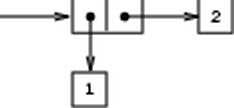As we have seen, pairs provide a primitive ``glue'' that we can use to
construct compound data objects.
Figure ![[*]](../image/cross_ref_motif.gif) shows a standard way to
visualize a
pair--in this case, the pair formed by (cons 1 2).
In this representation, which is called
box-and-pointer
notation, each object is shown as a
pointer to a box. The box
for a primitive object contains a representation of the object. For
example, the box for a number contains a numeral. The box for a pair
is actually a double box, the left part containing (a pointer to) the
car of the pair and the right part containing the cdr.
shows a standard way to
visualize a
pair--in this case, the pair formed by (cons 1 2).
In this representation, which is called
box-and-pointer
notation, each object is shown as a
pointer to a box. The box
for a primitive object contains a representation of the object. For
example, the box for a number contains a numeral. The box for a pair
is actually a double box, the left part containing (a pointer to) the
car of the pair and the right part containing the cdr.
We have already seen that cons can be used to combine not
only numbers but pairs as well. (You made use of this fact, or
should have, in doing exercises ![[*]](../image/cross_ref_motif.gif) and
and ![[*]](../image/cross_ref_motif.gif) .) As a consequence, pairs provide a universal
building block from which we can construct all sorts of data
structures. Figure
.) As a consequence, pairs provide a universal
building block from which we can construct all sorts of data
structures. Figure ![[*]](../image/cross_ref_motif.gif) shows two ways
to use pairs to combine the numbers 1, 2, 3, and 4.
shows two ways
to use pairs to combine the numbers 1, 2, 3, and 4.


The ability to create pairs whose elements are pairs is the essence of
list structure's importance as a representational tool. We refer to
this ability as the
closure property of cons. In general,
an operation for combining data objects satisfies the closure property
if the results of combining things with that operation can themselves
be combined using the same operation.
![[*]](../image/foot_motif.gif) Closure is the key to power in
any means of combination because it permits us to create
hierarchical structures--structures made up of parts, which
themselves are made up of parts, and so on.
Closure is the key to power in
any means of combination because it permits us to create
hierarchical structures--structures made up of parts, which
themselves are made up of parts, and so on.
From the outset of chapter 1, we've made essential use of closure in
dealing with procedures, because all but the very simplest programs
rely on the fact that the elements of a combination can themselves be
combinations. In this section, we take up the consequences of closure
for compound data. We describe some conventional techniques for using
pairs to represent sequences and trees, and we exhibit a graphics
language that illustrates closure in a vivid way.
![[*]](../image/foot_motif.gif)